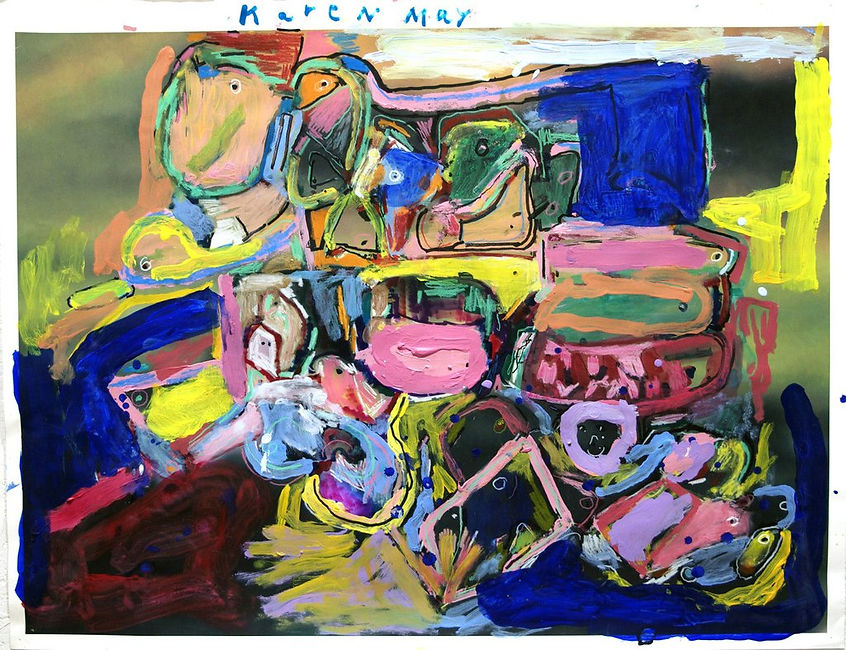
NIAD, or Nurturing Independence through Artistic Development Art Center (formerly The National Institute of Art and Disabilities) is an art studio for adults with developmental disabilities in Richmond, California. It is one of a trio of art studios created by Florence and Elias Katz, a husband and wife duo who pioneered the model that facilitated deinstitutionalization of people with developmental disabilities and provided a space for folks to make meaningful work. NIAD was founded in 1982, 10 years after the Katzes founded Creative Growth and one year before they founded Creativity Explored in San Francisco.

I Like Purple (D6506), Sara Malpass, 2014.
I pay my first in-person visit to the studio on a wet, blue day in mid-December. I arrive late morning and take my time browsing the exhibition Souls And Scenarios, organized by Gina Borg. Before heading into the studio, I find my way to the flat files in the back of the gallery where finished two-dimensional work is stored for purchase. I flip through the stacks and come across a text piece—thick matte black ink on soft white paper that asserts simply, “I like purple” in bold hand-drawn font. I can’t help but laugh aloud at the surprising and sublime directness of the work. The gallery director finds me there in the midst of laughing to myself and, unphased, proceeds to give me a whirlwind tour through the studio. There, I meet Liam, the studio manager, who is gracious and warm and allows me to stroll around each work space. There is painting in one corner, fabric and soft sculpture in another area, and ceramics in the back near the dining room. The space is suffused with a palpable exuberance regarding the holidays just around the corner.
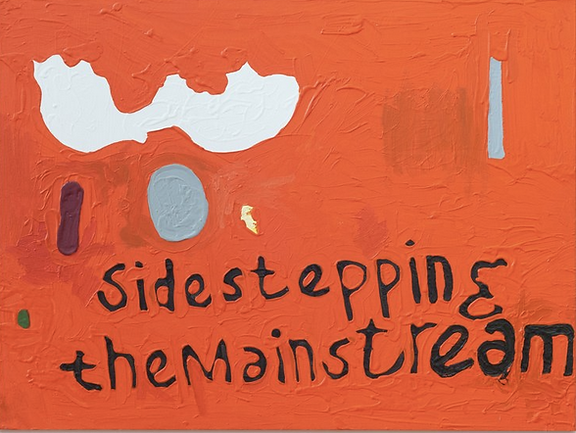
A few dozen artists are there that day, all bustling away and many creating intriguing work; Marlon Mullen, a man of few words, paints a large rendition of a book cover. I watch him as he edits, noting what shapes and forms he includes from his reference material and what he leaves out; how he carefully lays down a single, chunky line of paint at a time, covering his oversized painting surface with meticulous care. It looks like rich matte icing—Thiebaud-like. It’s as satisfying to watch as it is hypnotic. In his finished pieces, the linework has a real, raised texture and catches the light delicately, showing up like a map of concentric rings around each positive shape.
"A FEW DOZEN ARTISTS ARE THERE THAT DAY, ALL BUSTLING AWAY AND MANY CREATING INTRIGUING WORK; MARLON MULLEN, A MAN OF FEW WORDS, PAINTS A LARGE RENDITION OF A BOOK COVER."
Untitled, Marlon Mullen, 2014.
I notice Jeremy Burleson sits at a table by himself making his incredible lanterns, carefully wrapping paper and glue in fantastic assemblages that are reminiscent of rib cages or IV drips. There are occasionally eye-popping additions of color—splashes of CMYK against the mostly cream or white structures. He takes great care taping his forms to preserve their shape and is somehow also extremely prolific. He also makes enormous paper needles with sharp metallic-looking tips, as dangerous as they are beautiful.
"IN REVISITING THE RECORDING I MADE OF CONVERSATIONS THAT DAY, I’M STRUCK BY THE DEPTH AND VARIETY OF AUDITORY INFORMATION... IT CAN BE OVERWHELMING AT TIMES, BUT THERE’S ALSO A WILD ENERGY TO IT—AN ENTICING, INFECTIOUS VITALITY."
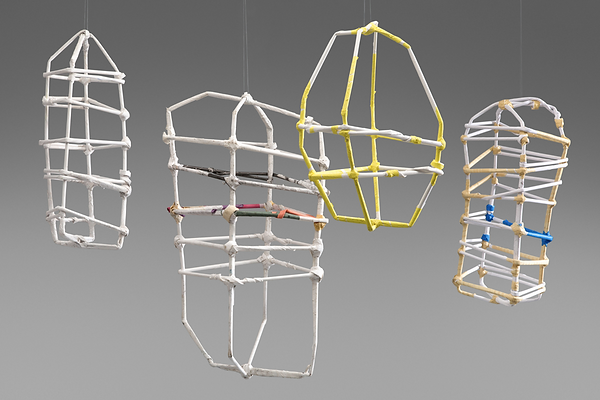
Lanterns, Jeremy Burleson, n.d.
I’m pulled aside by another man in the same area who paints on an easel. He speaks with an unhurried and deliberate drawl that draws me in. The lanyard he wears has a name tag attached that reads what looks like “Arstand Billy White” (I am later corrected: it's actually "Astranda"). It seems that most staff and studio mates call him Billy but I ask what he prefers. First, he says what sounds like “Arstand,” but later he settles on Mr. White. He tells me that he wants to paint my portrait and I consent to sit for him. I interview Mr. White about his life as he paints my likeness. He begins with a deep dive, describing how, at seven years of age, he was hit by a car and given 45 minutes to live. He tells me that he used to have a girlfriend named Lisa who started dating someone else after his accident. He is generous with the details of his life, recalling that his father was an interesting man—a minister and a cameraman who could play the spiritual vibes. His mother fell in love with Mr. White’s father while they were in school in Pittsburg, CA. He shares about his grandmother, who used to live in a retirement home nearby, and Maxine, his Grandmother’s cousin, who he claims also used to work at NIAD. I ask him about what he cares about and he responds, “Making art. Van Gogh taught me how to do this. Van Gogh is the one that started me to do my stuff.” I wonder aloud, why him? Mr. White answers, “He’s famous. O.K.? Like all my pictures that I do be like Van Gogh.” I am slightly perplexed by his phrasing but move on to other questions. I inquire about what’s important to Mr. White when he’s making artwork. He says he just wants to “make the people smile.” He seems to care a great deal about making people happy. When I ask him if he enjoys making artwork, he says, "It doesn’t mean nothing for me, but all it means is to make the people happy.” He’s a man of many skills who works across a variety of media. When I ask Mr. White what he likes the least about being an artist, he pauses and answers definitively, “The women.” I laugh and ask him to explain. He advises, “If you don’t make the women happy, then you might as well put everything up.”
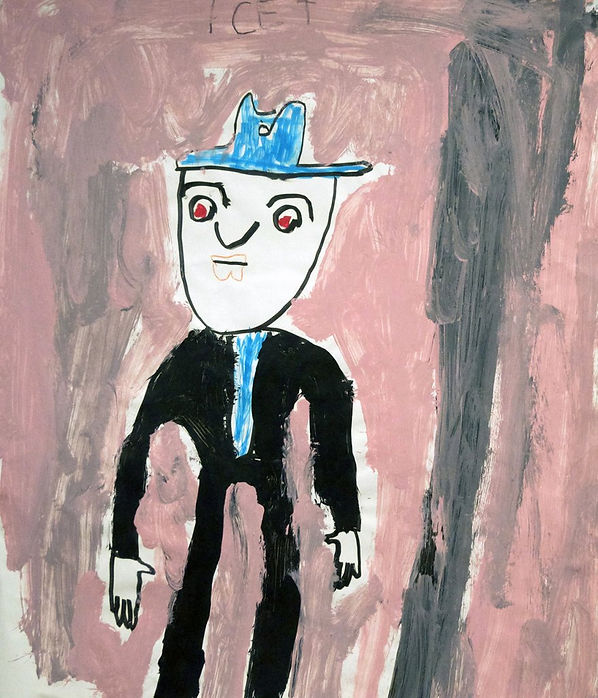
In revisiting the recording I made of conversations that day, I’m struck by the depth and variety of auditory information. There is a steady stream of laughter and bubbly chattering, warm words of encouragement between studio mates, exclamations, claps, hiccups, crinkling food wrappers, glasses and silverware clinking against one another, wolf whistling, moaning, and the clear, metallic sound of an analog bell piercing the air when the toaster has finished it’s work. It can be overwhelming at times, but there’s also a wild energy to it—an enticing, infectious vitality. It reminds me fondly of Creativity Explored.
Mr. White continues his story, returning to the beginning and recounting how he almost died. Apparently, Mr. White was in a coma for many years and when he woke up, he had to start his whole life all over again, relearning to walk, talk, eat, and sleep. Mr. White tells me this story casually over lunch while I toast his sandwich for him. The tale is interrupted by another artist, Danny, who gives me a sheet of lined binder paper with a short, handwritten list that includes the names of various local highways and freeways. He informs me that I am not his buddy. I am not entirely sure what to make of this but thank him for the paper and give it back to him after I’ve read it.
The recording finishes with Mr. White re-introducing himself to me, saying he is pleased to meet me. I tell him it’s nice to re-meet him.
“My name’s Billy,” he says.
I say, “Arstand, right? Mr. White?”
He says, “Uh huh. ”
Ice T (D1427), Billy White, n.d.
Artists are pleasantly distracted by my presence and eager to show me their work. I talk to one man who taught himself to knit watching how-to videos on YouTube. I meet another woman, Sylvia Fragoso, who quietly but insistently directs me to her elaborate clay structures, reminiscent of miniature coliseums. Her finished works are dripping with various glazes, giving the impression that they’re melting or oozing back into a slap even when completely fired. They have a terrifying beauty to them. I meet another fascinating lady, Miss Jean McElvane, in the midst of making a suite of elegantly painted ceramic hummingbirds. Some of the pieces have broken, so she creates prosthetic features, meticulously crafting the most extraordinarily beautiful tin foil wings that flicker and glint in the bright studio lights. They have long, slender beaks made from found objects. She is quite shy and vacillates between being proud and anxious, but opts to shows me her some of work—mainly depictions of birds.
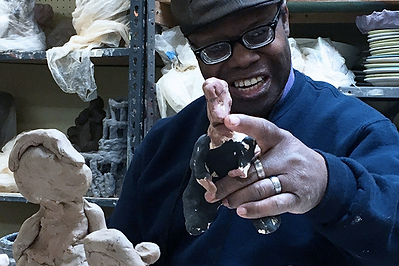
Mr. White working in NIAD’s ceramics studio.
In the ceramic area, I make my way over to speak with a woman named Karen May, who informs me that she was a little girl before she was born. Puzzled, I say to her, “That sounds complicated,” and she continues her story unphased, without further explanation. Apparently, sometimes her brother comes to take her out for lunch dates. When I ask her where she is from, I don’t get a clear answer. This bob-and-weave continues as our stream of consciousness conversation winds around. We talk about how she cares about people being nice to her. She informs me that she wants other people not to bother her while she’s making work. I ask if our conversation bothers her and she replies, “No.” I ask her about her favorite medium to work in/with and she shows me a colorful “purse bag” that she has hand-embellished. She is a joy to speak with, with her unrushed, careful delivery and her colorful and creative use of her voice(s).
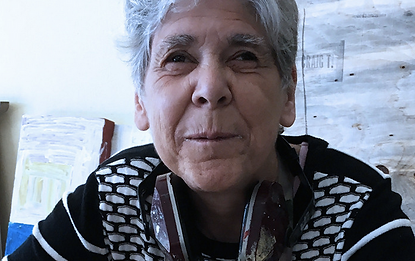
Karen May
She tells me that she likes to draw pictures and that she likes to make art because it’s fun. She shares that she likes looking at paintings by famous painters. She states, “some of them are real famous,” but she never does tell me who she’s referring to. Ms. May’s arm is in a cast, but what happened to her is unclear. When she describes her routine around taking a shower, she makes it sound as if she has to remove her cast in some way in order to do so. I playfully joke that she has to remove her entire arm before she can bathe and, annoyed with this nonsense, she insists, “That’s not what I do! That’s not what I do.” As a result, she seems to feel compelled to explain the process: that the cast goes into a “plastic hand bag.” She recounts that her hand was x-rayed not once but twice and states that “by the time you leave the hospital, they’re going to give you a bag for your hand. The right one bag. For one hand only. Not the left hand but the right hand.” I am dizzy and delighted trying to follow her unique verbal stylings.
"[SYLVIA'S] FINISHED WORKS ARE DRIPPING WITH VARIOUS GLAZES, GIVING THE IMPRESSION THAT THEY’RE MELTING OR OOZING BACK INTO A SLAP EVEN WHEN COMPLETELY FIRED."
She conveys to me that she likes to draw pictures of her house, and says that her house number is 109. She tells me, “Each time I draw something, it looks like a pretty, pretty picture.” She slows her cadence and drops the pitch of her voice to add dramatic emphasis to “pretty.” She’d mentioned earlier that she likes to draw and paint fish. When I ask her about this, she tells me that she likes fish because “they swim, that’s one of the reasons.” Ms. May thinks it’s important to work slowly and to only do one thing at a time. When she tells me about making her bed, I ask her what the best advice she’d ever received is. Her advice: that no one touches her in any way.
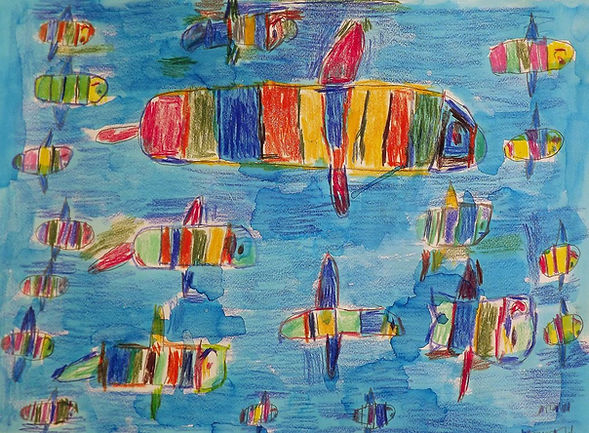
Untitled (D1076), Karen May, 2013.
She tells me she spends most of her days working in her house and watching television. She name drops the Judge Judy program, which apparently comes on twice daily. She also describes another show (which she doesn’t name) that apparently comes on just before the second rebroadcast. It sounds suspiciously like Jeopardy, but I can’t know for sure. Whatever it is, she seems to have the schedule down pat. It’s nearing the end of the day and I inquire about what happens when the program is over. “We close at the time when the buses roll in,” she states, matter-of-factly. "What time is that?" I continue. She says she looks at the clock and it tells her the time. Speaking with her feels a bit like trying to get a straight answer out of the Cheshire Cat. Every question I ask leaves me more confused than when I started. I am enchanted by her inscrutability and the absurdity of our dialogue. It’s the most DaDa conversation I’ve had in recent memory.
I ask her to describe herself and she states, “I always look like a woman,” and goes on to explain, “I stay away from some people I know, but I AM a lady.” When I ask her what it means to be a lady, I find more questions than answers: “I work around,” she says. She “keeps her eyes away” from her housemate who sometimes starts acting up when she wants Ms. May to give her something, like paper. Of this scenario, she warns: “You know what it sounds like to me? Trouble.” On what motivates her or gets her up in the morning? She replies with specifics: she gets up around 6 a.m. and some days she likes to do work in her books. I do not see the books she refers to, but guess that she means the art periodical and magazine pages that she removes and alters with permanent marker and other materials. The work was recently compiled into a book published by Books For All Press (BFA).

Her communication style is curiously clear and obfuscated; complex and matter-of-fact, not unlike her art. There is an alertness fostered by the way she nimbly skips between subjects. Our dialogue is gleefully present-tense, full of surprising connections between thoughts, which leaves me scrambling to assemble the relationships between ideas in my mind as the conversation marches forward.
I ASK [MS. MAY] TO DESCRIBE HERSELF AND SHE STATES, “I ALWAYS LOOK LIKE A WOMAN” AND GOES ON TO EXPLAIN, “I STAY AWAY FROM SOME PEOPLE I KNOW, BUT I AM A LADY. WHEN I ASK HER WHAT IT MEANS TO BE A LADY, I FIND MORE QUESTIONS THAN ANSWERS: “I WORK AROUND,” SHE SAYS.”
Untitled (D2735), Karen May, 2015.
I return to the work of Sara Malpass who, I’m told, identifies herself as “The Word Woman.” According to staff, Ms. Malpass is one of the senior artists at NIAD; a woman in her 50s who rarely misses a day. She is, unfortunately, not in attendance on the day of my visit but I’m intrigued by her stand-alone ceramic words, carved out of thick slabs of clay in cursive and glazed in various colors. They hover on the wall above the ceramics work area. It’s wonderfully uncanny to see three-dimensional words suspended in this way. I ask her instructors about her process, and they describe how she retrieves reference books and magazines from a small shelf in the studio and selects words and sentences to transcribe. The selection process is enigmatic. Staff inform me that the connections she makes between the color of the word and the word itself are often unexpected, like “Milk” in blue, and “Water” in brown. Or “Male” in a frosty pink and purple glaze, and “Man” in fire-engine red. The ceramic words are at once fragile and solid. I think of the well-worn rhyme, “Sticks and stones will break my bones…” and how these words could deal a serious blow if they were lobbed at you. I am excited to learn that there is an upcoming exhibition featuring this work.
Ms. Malpass is the consummate list maker. There are countless stacks of what could be indexes, inventories, menus, accounts, archives, or directories of words and phrases, all of which are splendidly opaque. They are usually numbered, written in her distinctive cursive lettering, and drafted on all kinds of work surfaces, from lined binder sheafs to craft paper to sheet music. They beg the reader to make connections between each entry without direction or explanation.
"THERE IS SOMETHING ODDLY PERFECT ABOUT ONLY MEETING [SARA] THROUGH HER WORDS. . . SHE REMAINS ELEGANTLY ENIGMATIC IN MY MIND."
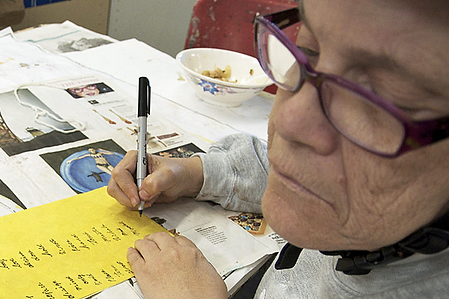
Sara Malpass making a list at NIAD’s studio.
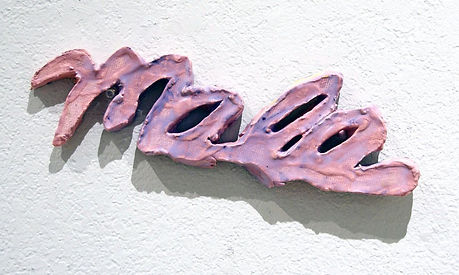
Male (S2197), Sara Malpass, 2015.
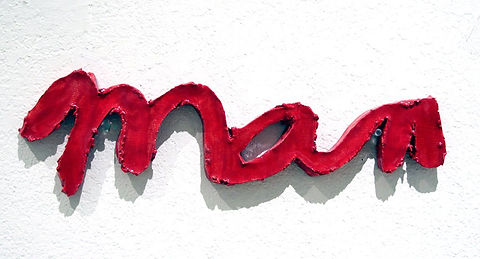
Man (S2209), Sara Malpass, 2015.
One list reads:
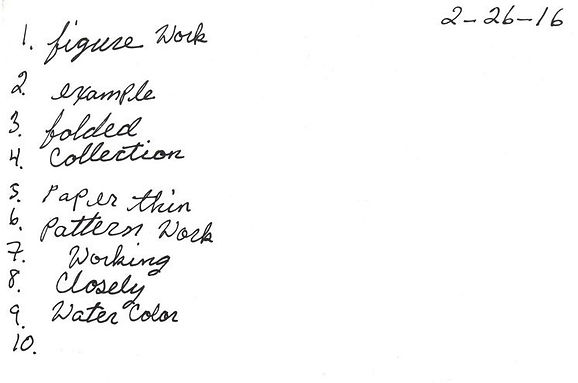
What happened to number 10? What was her relationship to her instructor when she wrote this? Was the instructor trying to introduce to new ideas or had she simply picked up an art periodical that featured a figurative painter? What else happened on February 26th, 2016? Like speaking with Karen May, I am left with more questions than answers.
As noted earlier, Ms. Malpass also creates poster-sized pieces with short phrases or clusters of words, often skewed hopefully upward and inscribed in rich black ink on bright white paper, such as “Example Whole Sale Noise” or “Lemon Art Work.” They are charmingly terse and, on some level, incomprehensible. I’ll never know what kind of “example” she’s referring to or what wholesale noise sounds like. Even if I could know, I don’t think I’d want to. Much of the art I’m drawn to or believe to be successful has an element of ambiguity to it. It’s the open-endedness that lures the viewer in. There is something oddly perfect about only meeting Ms. Malpass through her her words. Like the connections between them and the colors with which she chooses to adorn them (or the terms and phrases she selects), she remains elegantly enigmatic in my mind. The relationships between her words and their meaning(s) remain cryptic, but I’m not so sure that anything is lost in translation. The ambiguity begets an abundance of activity in my brain. It is much more generative and satisfying in my mind to not have Ms. Malpass spell it all out for me.

Danielle Wright is a visual artist based in the San Francisco Bay Area. She earned a B.A. in Visual Arts with an emphasis in Fine Arts at the University of San Francisco in 2007. Her work investigates the language of materials and the delineation between artist and viewer/participant. In addition to her studio practice, she teaches at Creativity Explored, a not-for-profit art gallery and studio in the Mission District of San Francisco.
